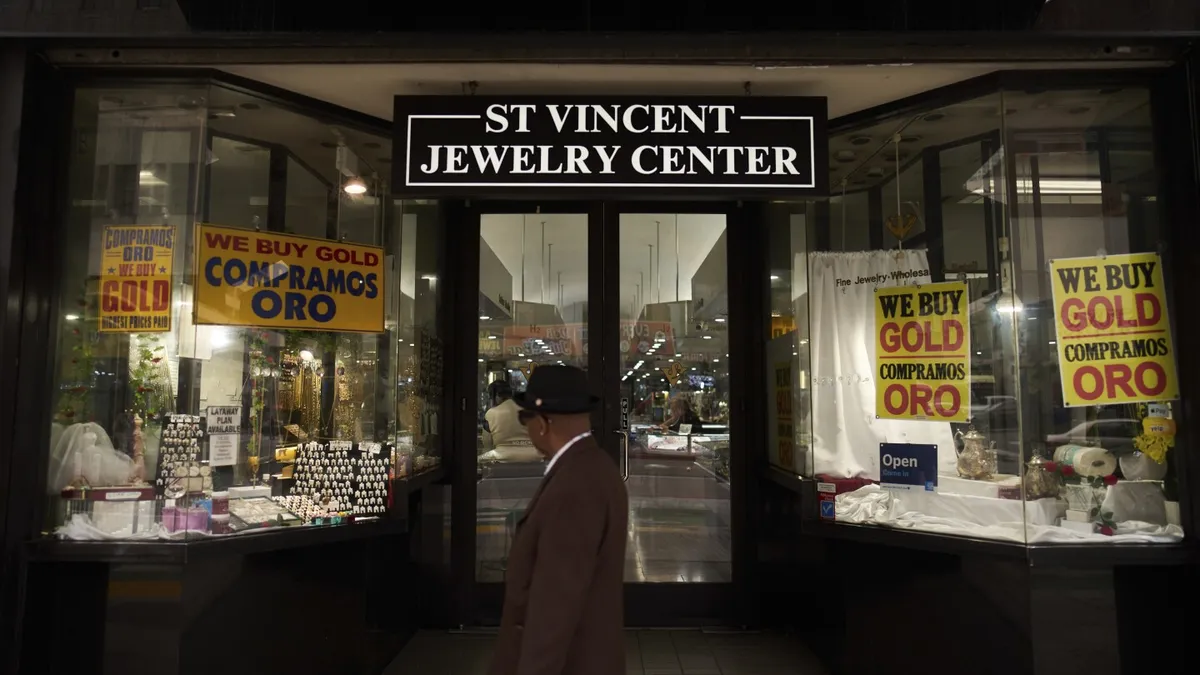
In the bustling heart of downtown Los Angeles, the St. Vincent Jewelry Center stands as the largest jewelry hub in the United States. Recently, Alberto Hernandez, an expert in gold refining, ignited his machine, which soon glowed a bright orange. He then proceeded to load it with an eclectic mix of jewelry, including rings, earrings, and necklaces, weighing just under 100 grams (approximately 3.2 troy ounces). Within minutes, the bubbling liquid metal was cooling in a cast the size of a women's shoe. An X-ray machine confirmed the metal’s purity at 56.5% gold, translating to a staggering value of $177,000 based on the day's gold prices.
As global economic uncertainty drives gold prices to unprecedented heights, the St. Vincent Jewelry Center is experiencing a significant influx of gold transactions. On any given day, hundreds of thousands of dollars' worth of gold are exchanged within its walls. Many of the center's 500 independent tenants, ranging from jewelers to gold refiners and assayers, report an unprecedented surge in customer activity. “Right now, we’re seeing many rappers and other celebrities melting down their large pieces,” noted Sabashden Hernandez, Alberto's nephew, who works at A&M Precious Metals. “We're also seeing new customers who are bringing in their grandfather's jewelry to melt down.”
The current rally in gold prices coincides with a series of fluctuating tariff announcements from former President Donald Trump, which have unsettled financial markets and reignited fears of inflation. As a result, individuals across the nation are rushing to sell or melt their old jewelry for quick cash. This trend extends to middlemen, such as pawn shop owners, who are also witnessing increased business. Others, viewing gold as a safer investment than the volatile stock market, are eagerly purchasing the precious metal.
Los Angeles jeweler Olivia Kazanjian has seen an increase in clients bringing in family heirlooms. “People are melting down pieces that have their family's wedding dates engraved, as well as items from the 1800s,” she shared. Recently, she compensated a client for a 14-karat gold woven bracelet adorned with intricate blue enamel, which she estimated could be transformed into a stunning brooch. The customer received $3,200, reflective of the gold content measured in troy ounces. However, Kazanjian opted not to melt the piece, recognizing its artistic and historical significance. “It’s a piece of history, and if you’re lucky enough to inherit it, it’s a piece of your family,” she emphasized.
While businesses on the buying side are thriving, those sourcing products from overseas—countries like Italy, Turkey, and China—are facing challenges. The combination of soaring gold prices and increased tariffs is squeezing profit margins and dampening demand. Puzant Berberian, whose family founded V&P Jewelry within St. Vincent in 1983, remarked, “Our profit margins are razor thin here.” He recently incurred an additional $16,000 cost on an overseas shipment, illustrating the financial strain many jewelers are currently facing.
Consumers are also feeling the pinch, experiencing “sticker shock” as prices climb. For example, a chunky 14-karat gold bracelet weighing about 10 grams (0.32 troy ounces) that previously sold for around $600 last year has now jumped to approximately $900, according to Berberian. Some experts believe this upward trend in gold prices may persist. Customers looking to invest in gold bullion are optimistic, with the expectation that prices will continue to rise. Sam Nguyen of Newport Gold Post Inc. noted, “People think gold will go up even more.”
Gold has retreated from its record high of $3,500 per troy ounce, but analysts like Jeff Clark, founder of The Gold Advisor, predict it could reach between $4,000 and $5,000 by year’s end. Clark suggests that gold is often viewed as a safe haven during times of economic anxiety and uncertainty, leading to increased demand. “History shows it has gone much higher in the past,” he stated, referencing the gold price surge during the 1970s, where it increased 17-fold amid double-digit inflation rates. “If the fear and uncertainty continue among the populace, gold prices are likely to keep rising.”